OPEL CORSA 2009 Owners Manual
Manufacturer: OPEL, Model Year: 2009, Model line: CORSA, Model: OPEL CORSA 2009Pages: 284, PDF Size: 4.96 MB
Page 141 of 284

135
Climate control
Picture no: 18226s.tif
Air intake The air intakes in the engine compartment
in front of the windscreen must be kept free
of leaves, dirt and snow in order to provide
a supply of air.
Pollen filter The pollen filter cleans dust, soot, pollen
and spores from the air entering from
outside. The active carbon layer 3
eliminates most odours and noxious
environmental gases from the air.
Regular operationFor consistently good operation, the air
cooling system 3 must be switched on for
several minutes once per month regardless
of the weather and the time of year.
Operation not possible with the cooling
system switched on and when the outside
temperature is low. Service For optimal cooling performance, we
recommend that the climate control
system be checked annually, starting three
years after initial vehicle registration.
z Functionality and pressure test
z Heating functionality
z Leakage check
z Check of drive belts
z Cleaning of condenser and evaporator
drainage
z Performance check
Back to overview
Page 142 of 284
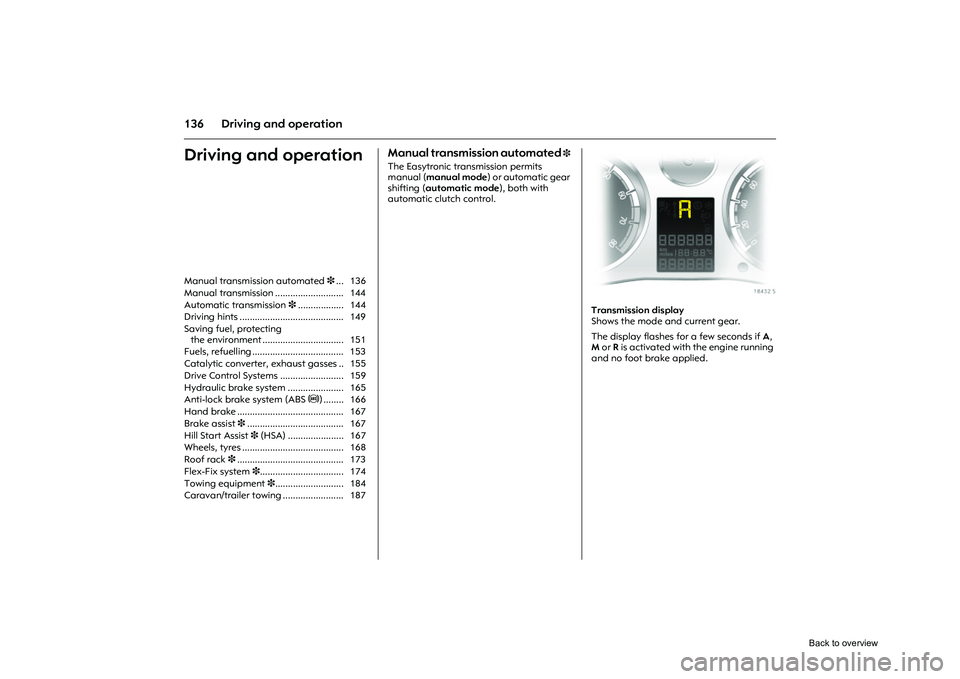
136 Driving and operationDriving and operation
Manual transmission automated
3
The Easytronic transmission permits
manual (manual mode ) or automatic gear
shifting ( automatic mode ), both with
automatic clutch control.
Picture no: 18432s.tif
Transmission display
Shows the mode and current gear.
The display flashes for a few seconds if A,
M or R is activated with the engine running
and no foot brake applied.
Manual transmission automated
3... 136
Manual transmission ........................... 144
Automatic transmission 3.................. 144
Driving hints ......................................... 149
Saving fuel, protecting the environment ................................ 151
Fuels, refuelling .................................... 153
Catalytic converter, exhaust gasses .. 155
Drive Control Systems ......................... 159
Hydraulic brake system ...................... 165
Anti-lock brake system (ABS u ) ........ 166
Hand brake .......................................... 167
Brake assist 3...................................... 167
Hill Start Assist 3 (HSA) ...................... 167
Wheels, tyres ........................................ 168
Roof rack 3.......................................... 173
Flex-Fix system 3................................. 174
Towing equipment 3........................... 184
Caravan/trailer towing ........................ 187
Back to overview
Page 143 of 284
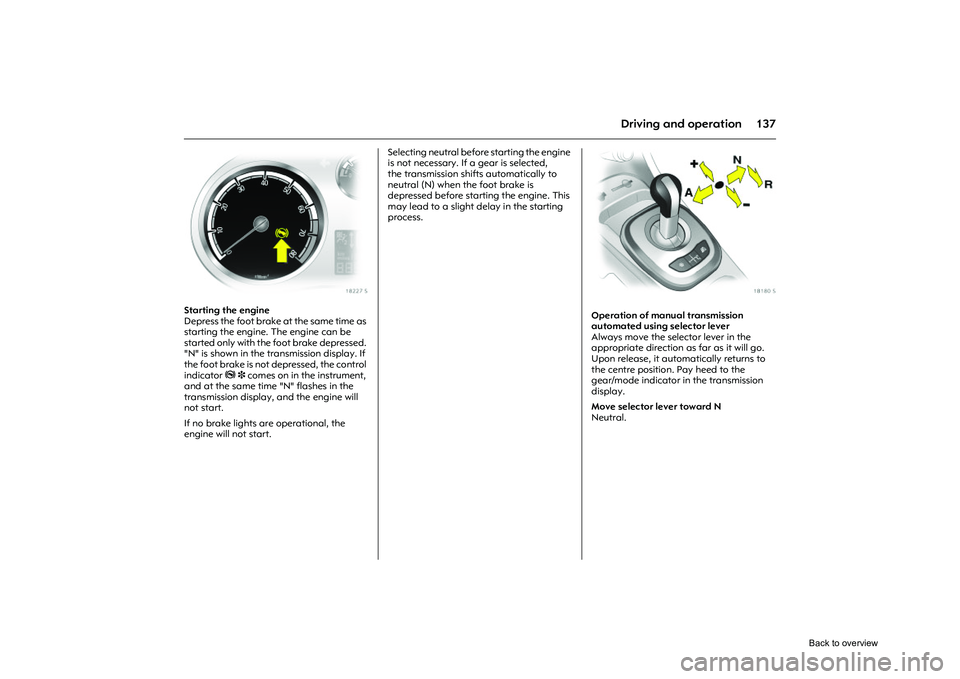
137
Driving and operation
Picture no: 18227s.tif
Starting the engine
Depress the foot brake at the same time as
starting the engine. The engine can be
started only with the foot brake depressed.
"N" is shown in the transmission display. If
the foot brake is not depressed, the control
indicator j 3 comes on in the instrument,
and at the same time "N" flashes in the
transmission display, and the engine will
not start.
If no brake lights are operational, the
engine will not start. Selecting neutral before
starting the engine
is not necessary. If a gear is selected,
the transmission shifts automatically to
neutral (N) when the foot brake is
depressed before starting the engine. This
may lead to a slight delay in the starting
process.
Picture no: 18180s.tif
Operation of manual transmission
automated using selector lever
Always move the selector lever in the
appropriate direction as far as it will go.
Upon release, it automatically returns to
the centre position. Pay heed to the
gear/mode indicator in the transmission
display.
Move selector lever toward N
Neutral.
Back to overview
Page 144 of 284
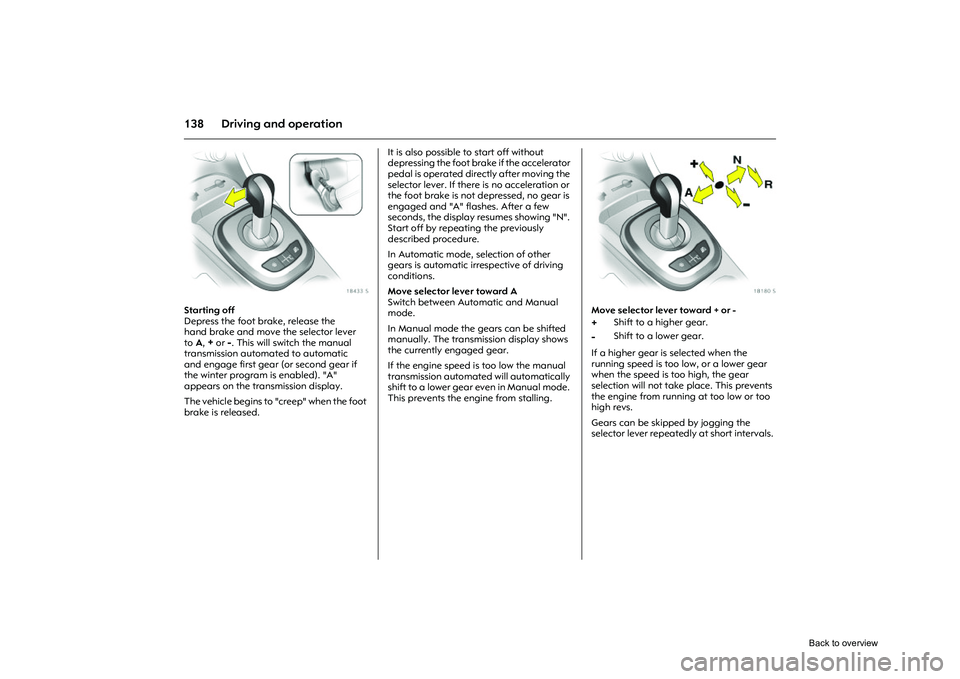
138 Driving and operation
Picture no: 18433s.tif
Starting off
Depress the foot brake, release the
hand brake and move the selector lever
toA,
+or-. This will switch the manual
transmission automated to automatic
and engage first gear (or second gear if
the winter program is enabled). "A"
appears on the transmission display.
The vehicle begins to "creep" when the foot
brake is released. It is also possible to start off without
depressing the foot brake if the accelerator
pedal is operated directly after moving the
selector lever. If there
is no acceleration or
the foot brake is not depressed, no gear is
engaged and "A" flashes. After a few
seconds, the display resumes showing "N".
Start off by repeating the previously
described procedure.
In Automatic mode, selection of other
gears is automatic irrespective of driving
conditions.
Move selector lever toward A
Switch between Automatic and Manual
mode.
In Manual mode the gears can be shifted
manually. The transmission display shows
the currently engaged gear.
If the engine speed is too low the manual
transmission automated will automatically
shift to a lower gear even in Manual mode.
This prevents the engine from stalling.
Picture no: 18180s.tif
Move selector lever toward + or -
If a higher gear is selected when the
running speed is too low, or a lower gear
when the speed is too high, the gear
selection will not take place. This prevents
the engine from running at too low or too
high revs.
Gears can be skipped by jogging the
selector lever repeatedly at short intervals. +
Shift to a higher gear.
-
Shift to a lower gear.
Back to overview
Page 145 of 284
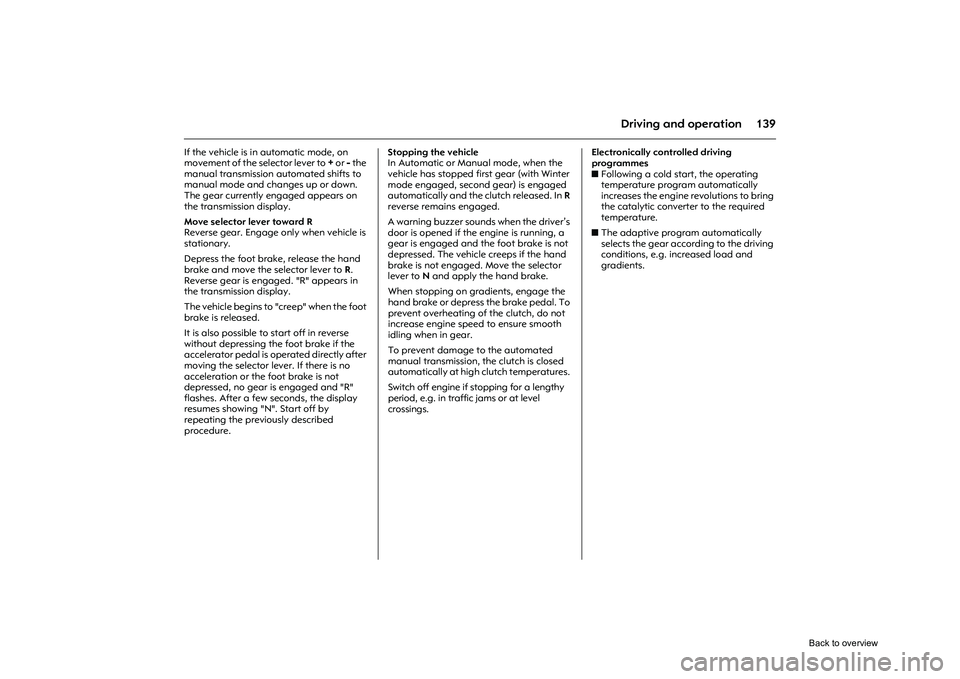
139
Driving and operation
If the vehicle is in automatic mode, on
movement of the selector lever to
+ or
- the
manual transmission automated shifts to
manual mode and changes up or down.
The gear currently engaged appears on
the transmission display.
Move selector lever toward R
Reverse gear. Engage only when vehicle is
stationary.
Depress the foot brake, release the hand
brake and move the selector lever to R.
Reverse gear is engaged. "R" appears in
the transmission display.
The vehicle begins to "creep" when the foot
brake is released.
It is also possible to start off in reverse
without depressing the foot brake if the
accelerator pedal is operated directly after
moving the selector lever. If there is no
acceleration or the foot brake is not
depressed, no gear is engaged and "R"
flashes. After a few seconds, the display
resumes showing "N". Start off by
repeating the previously described
procedure. Stopping the vehicle
In Automatic or Manual mode, when the
vehicle has stopped first gear (with Winter
mode engaged, second gear) is engaged
automatically and the clutch released. In
R
reverse remains engaged.
A warning buzzer sounds when the driver’s
door is opened if the engine is running, a
gear is engaged and the foot brake is not
depressed. The vehicle creeps if the hand
brake is not engaged. Move the selector
lever to N and apply the hand brake.
When stopping on gradients, engage the
hand brake or depress the brake pedal. To
prevent overheating of the clutch, do not
increase engine speed to ensure smooth
idling when in gear.
To prevent damage to the automated
manual transmission, the clutch is closed
automatically at high clutch temperatures.
Switch off engine if stopping for a lengthy
period, e.g. in traffic jams or at level
crossings. Electronically controlled driving
programmes
z
Following a cold start, the operating
temperature program automatically
increases the engine revolutions to bring
the catalytic converter to the required
temperature.
z The adaptive program automatically
selects the gear according to the driving
conditions, e.g. increased load and
gradients.
Back to overview
Page 146 of 284
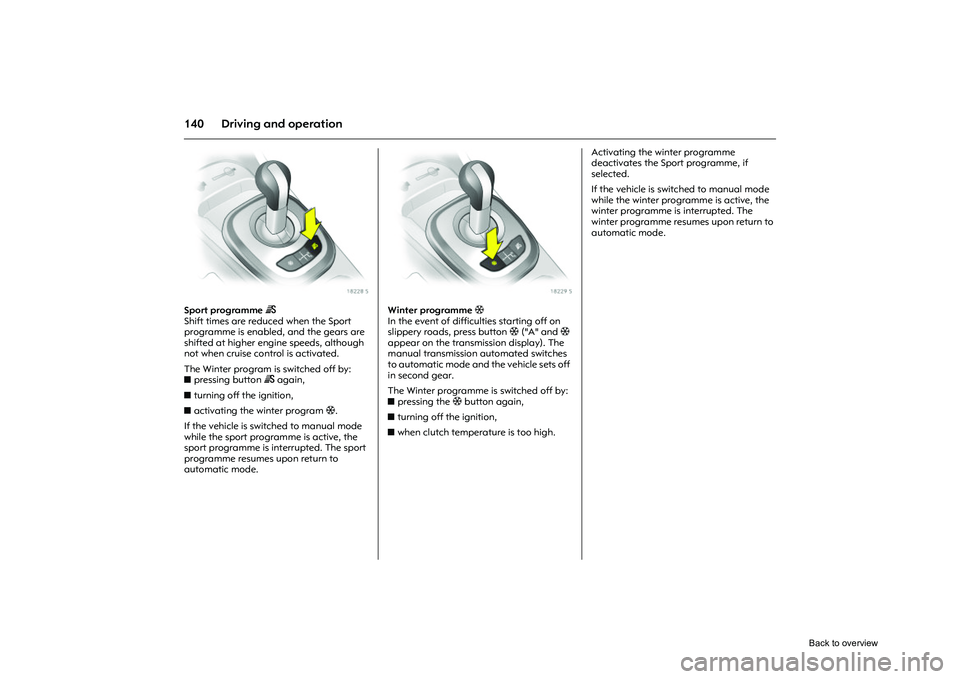
140 Driving and operation
Picture no: 18228s.tif
Sport programme =
Shift times are reduced when the Sport
programme is enabled, and the gears are
shifted at higher engine speeds, although
not when cruise control is activated.
The Winter program is switched off by:
z pressing button = again,
z turning off the ignition,
z activating the winter program T .
If the vehicle is switched to manual mode
while the sport programme is active, the
sport programme is in terrupted. The sport
programme resumes upon return to
automatic mode.
Picture no: 18229s.tif
Winter programme T
In the event of difficulties starting off on
slippery roads, press button T ("A" and T
appear on the transmission display). The
manual transmission automated switches
to automatic mode and the vehicle sets off
in second gear.
The Winter programme is switched off by:
z pressing the T button again,
z turning off the ignition,
z when clutch temperature is too high. Activating the winter programme
deactivates the Sport programme, if
selected.
If the vehicle is switched to manual mode
while the winter prog
ramme is active, the
winter programme is interrupted. The
winter programme resumes upon return to
automatic mode.
Back to overview
Page 147 of 284

141
Driving and operation
Picture no: 18451s.tif
Kickdown
If the accelerator pedal is pressed past the
pressure point, the transmission shifts to a
lower gear depending on engine speed.
During kickdown no manual gear shifting is
possible. When the engine speed approaches its
upper limit, the transmission shifts to a
higher gear during kickdown even in
Manual mode.
Without kickdown this automatic shift is
not effected in Manual mode.
If the SPORT programme is engaged, the
driven wheels may spin slightly when
starting off with kickdown. This allows for
maximum acceleration of the vehicle.
Engine braking
Automatic mode
When driving downhill, the manual
transmission automated does not shift into
higher gears until a fairly high engine
speed has been reached. When braking,
the manual transmission automated shifts
down in good time.
Manual modeTo utilise the engine braking effect, select a
lower gear in good time when driving
downhill. "Rocking the car"
Move selector lever between
R and A
(or + or -) while applying light pressure to
the accelerator pedal ONLY if the vehicle
has to be rocked to free it from sand, mud,
snow or a hole. Do not race the engine and
avoid sudden acceleration.
Back to overview
Page 148 of 284
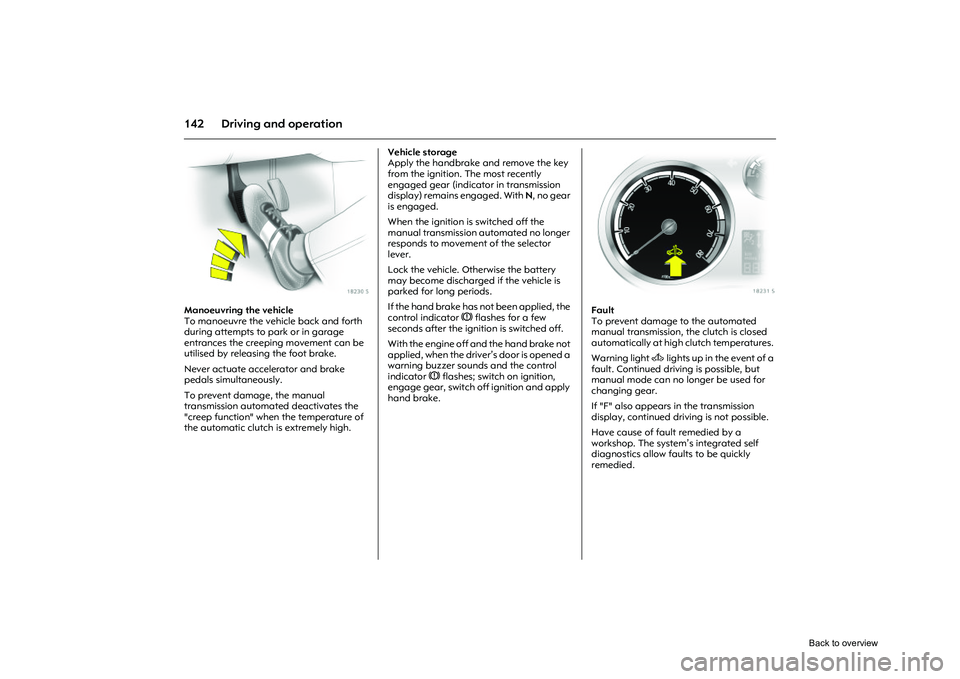
142 Driving and operation
Picture no: 18230s.tif
Manoeuvring the vehicle
To manoeuvre the vehicle back and forth
during attempts to park or in garage
entrances the creeping movement can be
utilised by releasing the foot brake.
Never actuate accelerator and brake
pedals simultaneously.
To prevent damage, the manual
transmission automated deactivates the
"creep function" when the temperature of
the automatic clutch is extremely high. Vehicle storage
Apply the handbrake and remove the key
from the ignition. The most recently
engaged gear (indicator in transmission
display) remains engaged. With
N, no gear
is engaged.
When the ignition is switched off the
manual transmission automated no longer
responds to movement of the selector
lever.
Lock the vehicle. Otherwise the battery
may become discharged if the vehicle is
parked for long periods.
If the hand brake has not been applied, the
control indicator R flashes for a few
seconds after the ignition is switched off.
With the engine off and the hand brake not
applied, when the driver ’s door is opened a
warning buzzer sounds and the control
indicator R flashes; switch on ignition,
engage gear, switch off ignition and apply
hand brake.
Picture no: 18231s.tif
Fault
To prevent damage to the automated
manual transmission, the clutch is closed
automatically at high clutch temperatures.
Warning light A lights up in the event of a
fault. Continued driving is possible, but
manual mode can no longer be used for
changing gear.
If "F" also appears in the transmission
display, continued driving is not possible.
Have cause of fault remedied by a
workshop. The system’s integrated self
diagnostics allow faults to be quickly
remedied.
Back to overview
Page 149 of 284
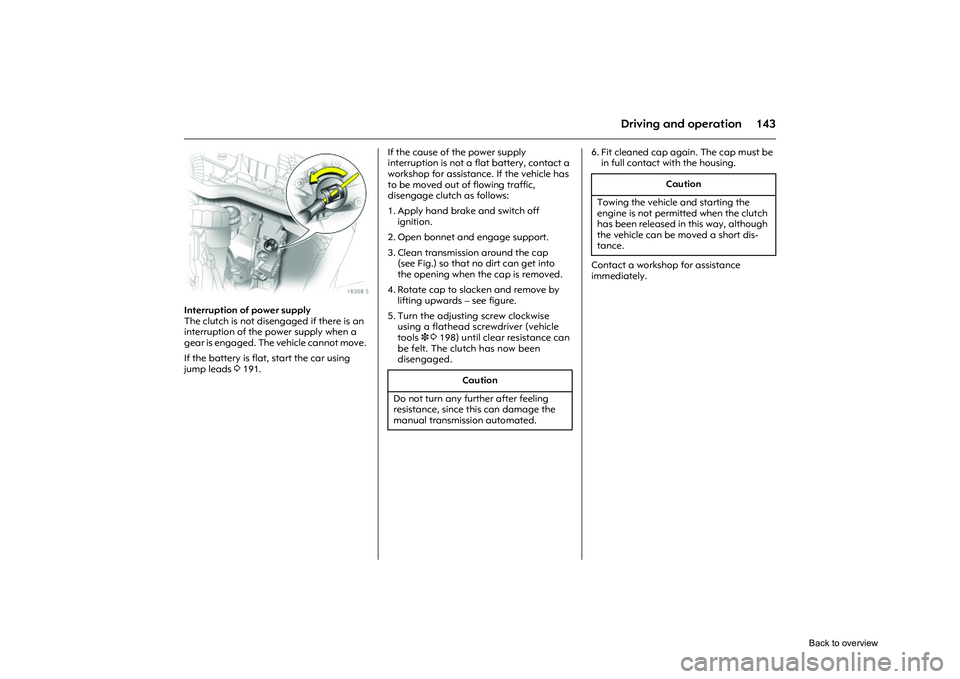
143
Driving and operation
Picture no: 18308s.tif
Interruption of power supply
The clutch is not disengaged if there is an
interruption of the power supply when a
gear is engaged. The vehicle cannot move.
If the battery is flat, start the car using
jump leads 3191. If the cause of the power supply
interruption is not a flat battery, contact a
workshop for assistance. If the vehicle has
to be moved out of flowing traffic,
disengage clutch as follows:
1. Apply hand brake and switch off
ignition.
2. Open bonnet and engage support.
3. Clean transmission around the cap (see Fig.) so that no dirt can get into
the opening when the cap is removed.
4. Rotate cap to slacken and remove by lifting upwards – see figure.
5. Turn the adjusting screw clockwise using a flathead screwdriver (vehicle
tools 3 3198) until clear resistance can
be felt. The clutch has now been
disengaged. 6. Fit cleaned cap again. The cap must be
in full contact with the housing.
Contact a workshop for assistance
immediately.
Caution
Do not turn any further after feeling
resistance, since this can damage the
manual transmission automated.
Caution
Towing the vehicle and starting the
engine is not permitted when the clutch
has been released in this way, although
the vehicle can be moved a short dis-
tance.
Back to overview
Page 150 of 284
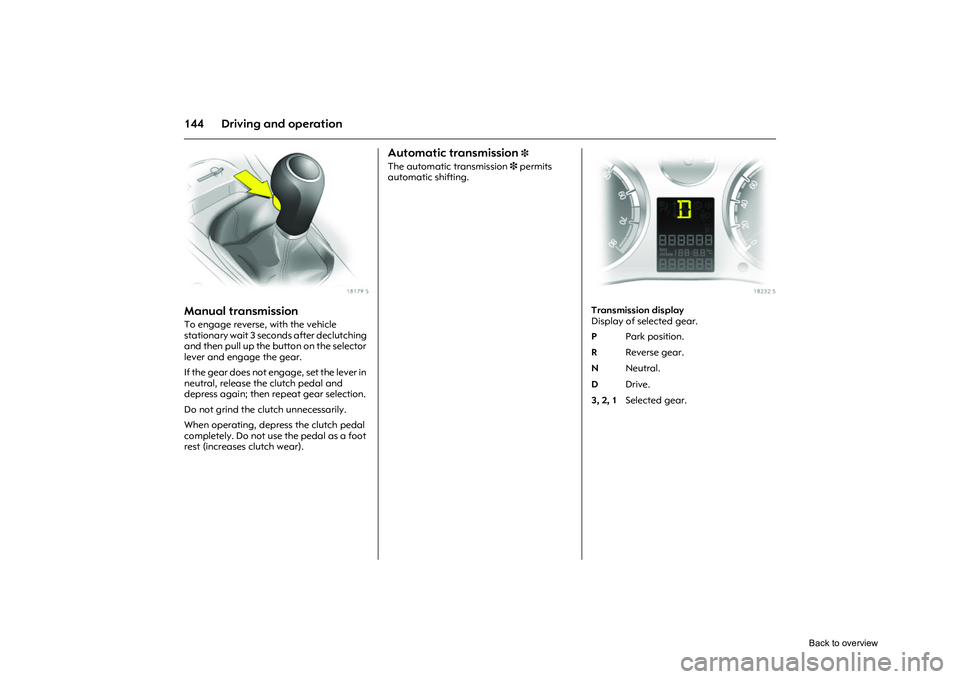
144 Driving and operation
Picture no: 18179s.tif
Manual transmissionTo engage reverse, with the vehicle
stationary wait 3 seconds after declutching
and then pull up the button on the selector
lever and engage the gear.
If the gear does not engage, set the lever in
neutral, release the clutch pedal and
depress again; then repeat gear selection.
Do not grind the clutch unnecessarily.
When operating, depress the clutch pedal
completely. Do not use the pedal as a foot
rest (increases clutch wear).
Automatic transmission
3
The automatic transmission 3 permits
automatic shifting.
Picture no: 18232s.tif
Transmission display
Display of selected gear. P Park position.
R Reverse gear.
N Neutral.
D Drive.
3, 2, 1 Selected gear.
Back to overview